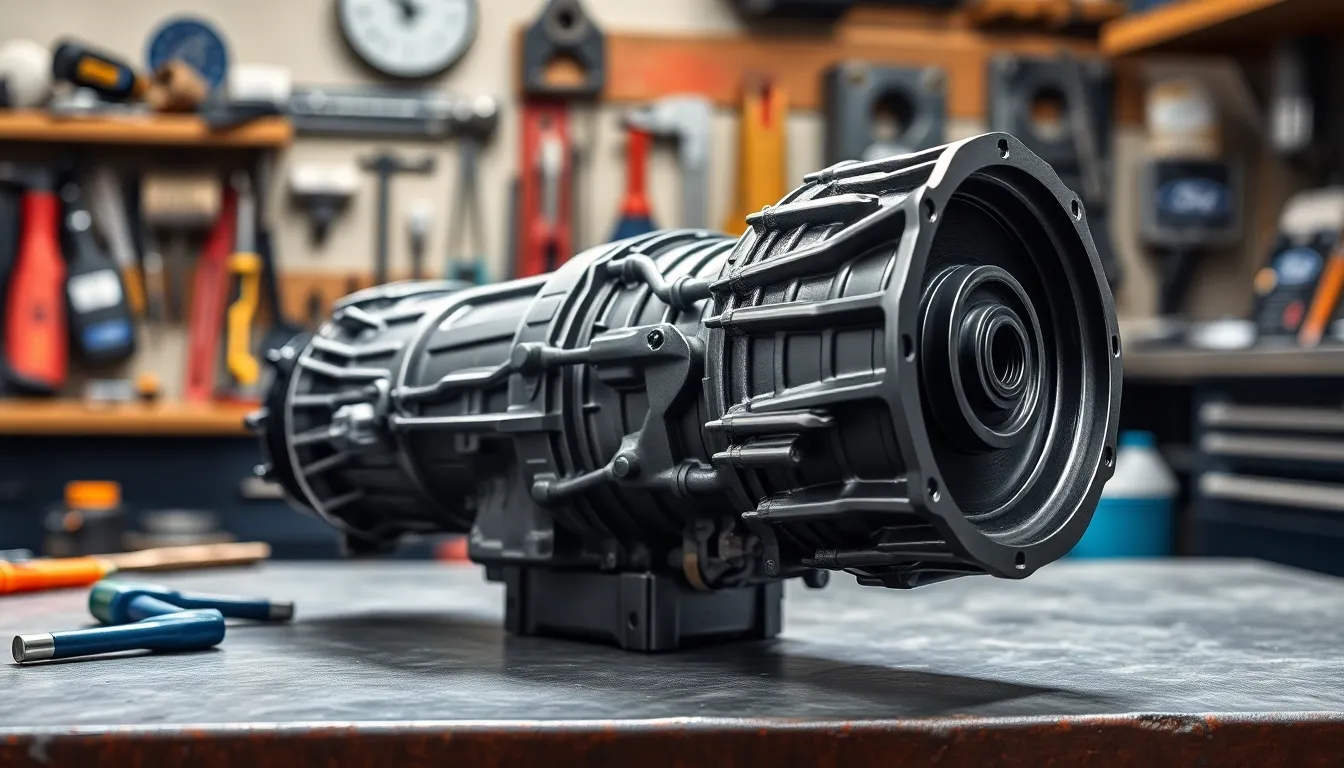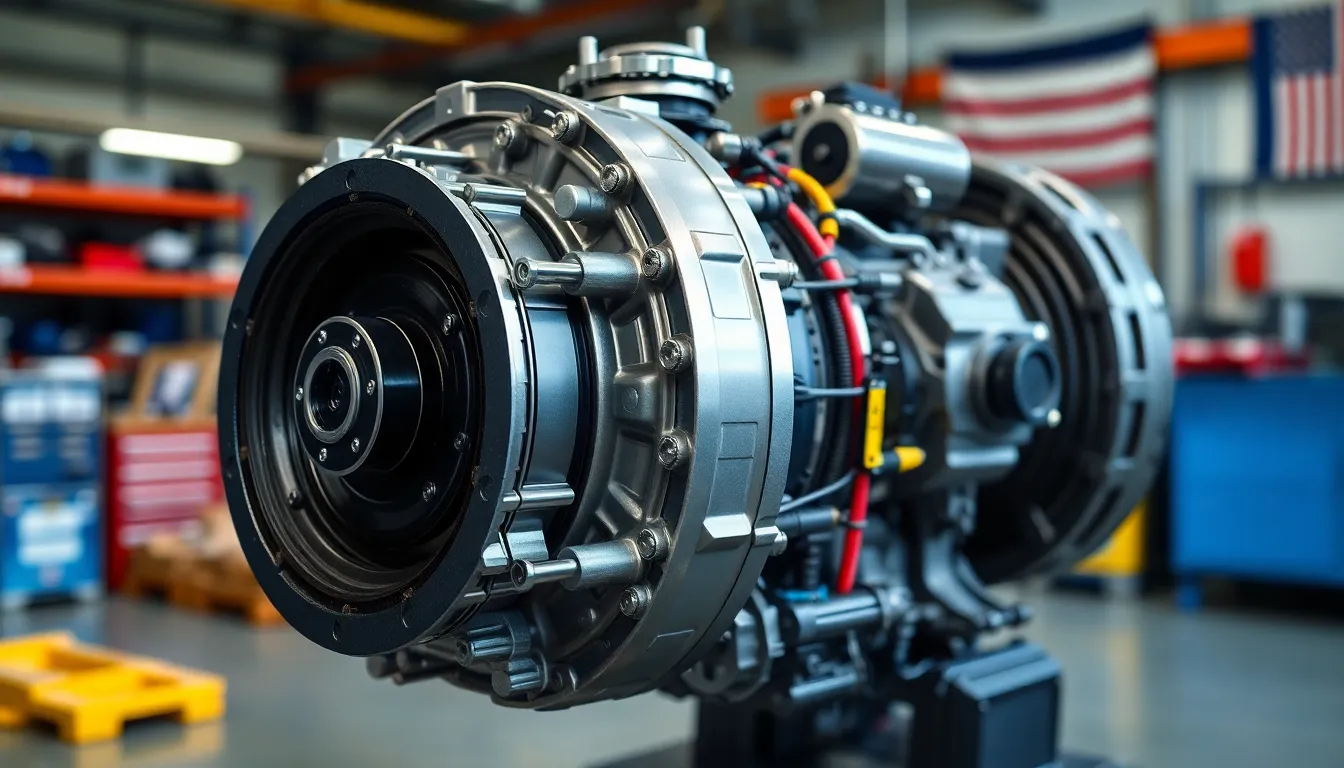Looking for the best truck transmission for your heavy-duty vehicle? Whether you’re hauling massive loads or handling challenging terrain, your choice of transmission can make or break your truck’s performance.
Today’s market offers multiple options—from traditional manual transmissions prized by purists to sophisticated automatics and innovative automated manuals. Each type comes with distinct advantages in terms of fuel efficiency, durability, and ease of operation. We’ll explore leading models from manufacturers like Allison, Eaton, and ZF that have proven their worth in commercial and personal trucks across America.
What Makes a Great Truck Transmission
A great truck transmission balances power delivery, efficiency, and reliability to handle demanding tasks. Leading transmissions distinguish themselves through several key attributes that directly impact performance across various driving conditions.
Durability and Build Quality
Truck transmissions face tremendous stress from hauling heavy loads and operating in harsh environments. Premium transmissions like Allison’s 4500 RDS incorporate hardened steel gears and robust case designs to withstand constant pressure. The materials used in construction dramatically affect longevity, with quality units featuring precision-machined components and specialized heat treatments to resist wear.
Many commercial fleet managers report significantly lower maintenance costs with higher-grade transmissions. For example, Liam Kohn notes that “after switching our fleet to Eaton UltraShift PLUS transmissions, we’ve seen repair incidents drop by nearly 40% over three years of operation.”
Power Handling Capacity
The ability to manage torque effectively separates exceptional transmissions from average ones. Top-tier models like the ZF TraXon can handle up to 2,800 Nm of torque, making them suitable for the heaviest loads. This capacity ensures smooth power delivery without strain, particularly when starting from a stop on inclines or when accelerating with substantial weight.
Proper torque multiplication through gear ratios provides the necessary leverage for challenging situations without overworking the engine. The transmission’s torque converter design (in automatics) or clutch system (in manuals and AMTs) plays a crucial role in transmitting engine power efficiently to the wheels.
Efficiency and Fuel Economy
Transmission efficiency directly impacts your operating costs through fuel consumption. Modern automated manual transmissions often provide 2-5% better fuel economy compared to conventional automatics. Features like intelligent shift scheduling, torque converter lockup, and optimized gear ratios contribute to these savings.
Advanced models incorporate predictive technologies that analyze road conditions, vehicle weight, and terrain to select the most efficient gear. The Eaton Endurant, for instance, uses GPS-based predictive shifting to anticipate hills and adjust shifting patterns accordingly, improving fuel consumption on long hauls.
Shift Quality and Operation
Smooth, precise shifting reduces driver fatigue and prevents cargo damage. High-quality transmissions minimize shift shock through sophisticated electronic controls and hydraulic pressure management. In manual transmissions, synchronized gear sets with quality synchromesh designs ensure effortless shifting.
Many drivers praise the Allison 3000 Series for its exceptionally smooth shifts under load. As veteran driver Mark Patterson shared with Liam Kohn, “After 20 years behind the wheel, I can tell you that shift quality makes all the difference during a 10-hour haul. My knees and back certainly appreciate the difference.”
Integration with Engine and Drivetrain
The best transmissions communicate seamlessly with engine management systems to optimize performance. Modern transmissions use sophisticated CAN bus networks to exchange data with the engine control unit, ensuring ideal shift points and torque management.
This integration extends to diagnostics and maintenance scheduling, with systems like Detroit Diesel’s Virtual Technician providing real-time transmission performance data. Such connectivity allows for preventive maintenance based on actual operating conditions rather than arbitrary mileage intervals.
Adaptability to Different Applications
Versatile transmissions accommodate various driving conditions without compromising performance. Configurations with multiple PTO (Power Take-Off) options support specialized equipment needs, while programmable shift points adapt to different loads and terrains.
The ability to customize shift parameters for exact applications makes transmissions like the Allison 4000 Series popular across diverse industries. These units can be optimized for everything from refuse collection to cement mixers, with appropriate shift timing and clutch engagement characteristics for each application.
Types of Truck Transmissions Explained

Truck transmissions come in several distinct varieties, each designed to meet exact operational needs and driving conditions. Understanding these differences helps you select the most appropriate transmission for your hauling requirements, terrain challenges, and driving preferences.
Manual Transmissions
Manual transmissions offer unmatched durability and maximum driver control over gear selection in trucks. These traditional systems typically feature 10-18 speeds, providing precise options for handling varied terrains while carrying heavy loads. Truck drivers appreciate manuals for their excellent fuel efficiency and remarkable reliability during tough hauling jobs. The direct mechanical connection between engine and wheels delivers power with minimal loss, making these transmissions particularly valuable for off-road applications or steep grade climbing. Even though requiring more skill to operate effectively, manual transmissions remain popular among experienced drivers who prefer complete control over their vehicle’s performance in challenging conditions.
Automatic Transmissions
Automatic transmissions enhance driving comfort by eliminating the need for manual shifting, reducing driver fatigue significantly during long hauls. These systems employ planetary gearsets and torque converters to seamlessly change gears based on speed and load conditions. Two prominent automatic variants exist in the truck market: planetary automatics offering smooth shifting across various driving conditions, and dual-clutch transmissions (DCTs) utilizing two separate clutches to pre-select gears for faster, more precise changes. DCTs excel in performance-oriented applications and hilly terrain situations by improving both drivability and fuel efficiency. Modern automatics have gained substantial popularity in heavy-duty trucking where driver comfort and operational convenience take priority over manual control.
Automated Manual Transmissions (AMTs)
Automated Manual Transmissions represent the perfect middle ground between traditional options, combining manual transmission efficiency with automatic convenience. AMTs maintain the internal structure of manual gearboxes while automating both clutch operation and gear shifting processes. These innovative systems deliver superior fuel economy compared to conventional automatics while eliminating the fatigue associated with constant manual shifting. Long-haul truckers particularly value AMTs for highway driving, where their balanced approach to efficiency and ease of operation proves invaluable during extended journeys. The growing adoption of AMTs in commercial fleets demonstrates their effectiveness in meeting the demands of modern trucking operations that prioritize both driver comfort and operational cost management.
Top Truck Transmissions for Heavy-Duty Applications

Heavy-duty applications demand transmissions that deliver exceptional performance, durability, and efficiency under extreme conditions. The two industry leaders—Eaton Fuller and Allison—have established themselves as top choices for commercial trucking operations across diverse environments and specialized needs.
Eaton Fuller Transmissions
Eaton Fuller transmissions dominate the manual and automated manual segment of heavy-duty trucking with their renowned reliability and versatility. These transmissions come in multiple configurations including 9, 10, 13, and 18-speed models, giving drivers precise control over power delivery and fuel consumption. Long-haul operators particularly appreciate Eaton Fuller’s exceptional durability under sustained heavy loads and challenging terrain conditions. The wide range of gear ratios enables optimal engine performance regardless of load weight or road gradient, maximizing both power and efficiency. Drivers experienced with these transmissions often praise their mechanical simplicity, which translates to fewer electronic components that could potentially fail during critical operations.
Allison Automatic Transmissions
Allison automatic transmissions excel in applications requiring smooth operation and reduced driver fatigue, especially in urban environments with frequent stops. Their fully automatic design features robust 12.2-inch torque converters that deliver superior pulling power from standstill positions compared to manual alternatives. These transmissions incorporate advanced electronics and shift logic systems that optimize performance based on load, gradient, and driving conditions. Vocational truck operators benefit from Allison’s smooth shifting characteristics that minimize wear on driveline components while maintaining momentum. Companies operating fleets with multiple drivers often select Allison automatics to standardize vehicle operation and reduce training requirements. Chevrolet and GMC heavy-duty trucks frequently feature these transmissions as standard equipment due to their proven track record for reliability and performance.
Best Transmissions for Light and Medium-Duty Trucks

For light and medium-duty trucks, transmission quality directly impacts towing capability, fuel efficiency, and overall performance. Two transmission systems consistently outperform competitors in these critical areas.
Ford TorqShift
Ford’s TorqShift transmission dominates the Super Duty truck lineup with exceptional durability and smooth shifting characteristics. This advanced system handles enormous torque loads from Ford’s powerful Power Stroke diesel and gasoline engines without compromising performance. The robust automatic design delivers reliable operation even during the most demanding towing and hauling situations. TorqShift transmissions significantly improve fuel efficiency while maintaining consistent performance under strenuous work conditions, making them ideal for contractors and businesses that rely on their trucks daily.
GM Allison Series
The Allison automatic transmission series represents the gold standard for General Motors pickups and commercial trucks. These transmissions earned their stellar reputation through unmatched longevity, exceptionally smooth gear changes, and superior handling of heavy payloads. Allison’s fully automatic design incorporates sophisticated electronic controls that optimize power delivery and efficiency in real-time. Their precision engineering ensures maximum torque transfer to the wheels while minimizing wear on drivetrain components. Many fleet managers prefer Allison-equipped trucks for their reduced maintenance requirements and impressive resale values compared to trucks with standard transmissions.
Both transmission options deliver excellent performance in demanding work environments, though modern alternatives like Hyundai’s 8-speed automatic found in the Santa Cruz offer compelling options for lighter-duty applications where urban driving and moderate towing predominate.
Factors to Consider When Choosing a Truck Transmission

Selecting the right transmission for your truck requires careful evaluation of several critical factors. Your exact operational needs will eventually determine which transmission type delivers the best performance and value for your investment.
Performance Requirements
Performance requirements directly influence your ideal transmission choice. Manual transmissions excel in heavy-load scenarios and challenging terrains, providing the robust durability and precise control needed for demanding applications. Their direct power delivery and driver-controlled shifting make them particularly effective when handling steep grades or managing heavy cargo. Automatic and AMT transmissions offer smoother operation in stop-and-go traffic conditions, reducing driver fatigue significantly during long hauls or urban deliveries. DCTs provide rapid acceleration and efficient power transfer, making them suitable for performance-oriented trucking applications where speed and responsiveness matter, such as time-sensitive deliveries in varied terrain.
Fuel Efficiency
Fuel efficiency varies considerably between transmission types, impacting your long-term operating costs. AMTs strike an optimal balance between the fuel economy of manual transmissions and the convenience of automatics, making them increasingly popular for long-haul operations. These transmissions automatically select the most efficient gear for current conditions while eliminating the potential for human error in shift timing. Ford’s advanced diesel transmissions incorporate specialized technology that optimizes fuel consumption without compromising power delivery during acceleration or climbing. Dual-clutch systems contribute to better fuel economy by minimizing power loss during gear changes, resulting in more efficient energy transfer from the engine to the wheels.
Maintenance Costs
Maintenance considerations play a crucial role in the total cost of ownership for your truck. Manual transmissions typically require less maintenance due to their simpler mechanical design and fewer electronic components, translating to lower repair costs and longer service intervals. Their straightforward construction means repairs can often be completed more quickly and at lower expense. Automatic and dual-clutch transmissions, while more complex and potentially more expensive to repair, offer operational benefits that might offset these higher maintenance expenses over time. Choosing established brands like Dodge RAM or Ford diesel transmissions, known for their rugged durability in challenging conditions, can significantly reduce your long-term maintenance concerns and extend the service life of your vehicle.
Future Trends in Truck Transmission Technology

Adaptive Electronic Control and Intelligent Software
Adaptive electronic controls have revolutionized how transmissions select gears based on real-time driving conditions and driver behavior patterns. These intelligent systems analyze multiple data points to determine optimal shift timing, resulting in smoother acceleration and improved fuel economy. In the Chevrolet Silverado’s 10-speed transmission, advanced electronic controls continuously adapt to your driving style, maintaining engine RPM in the sweet spot for maximum efficiency. This technology represents a important leap forward from traditional mechanical shifting mechanisms, creating a more responsive driving experience while reducing fuel consumption across various terrains and load conditions.
Torque Converter Innovations
Modern torque converters now feature turbine torsional dampers that enable lower lock-up speeds across multiple gears. The ZF PowerLine 8-Speed transmission exemplifies this innovation, allowing lock-up in all eight gears to minimize energy loss during transmission. These advanced converters reduce the power delay between engine and wheels, creating more immediate response when you press the accelerator. Reduced slippage translates to better fuel economy without sacrificing the smooth power delivery truck drivers depend on for hauling heavy loads.
Compact and Integrated Designs
Transmission manufacturers have embraced more compact, integrated designs that enhance reliability while simplifying maintenance requirements. The ZF PowerLine weighs just 328 pounds dry and measures under 30 inches in length, demonstrating the trend toward space-efficient engineering. Engineers now package peripheral components inside the transmission case, protecting vital systems from environmental damage and reducing external wiring. This integration creates more durable transmissions that withstand harsh operating conditions while maintaining performance standards over extended service lives.
Enhanced Safety Features
Safety innovations have become a central focus in transmission development, with features like Autopark and Hill Hold becoming standard in premium systems. Autopark automatically engages the parking lock when needed, preventing potential rollaway incidents. Hill Hold temporarily maintains brake pressure when starting on inclines, giving you time to transition from brake to accelerator without rolling backward. These intelligent safety systems compensate for human error and enhance vehicle control in challenging situations, making modern trucks safer to operate in diverse environments.
Expanded Power Take-Off Capabilities
Trucks with versatile PTO options offer greater utility for commercial applications. The latest transmissions, including the ZF PowerLine, feature PTO capability on both sides, creating more installation flexibility for auxiliary equipment. This dual-sided approach allows businesses to power multiple accessories from a single transmission, expanding the functional capabilities of work trucks. The growing emphasis on PTO versatility reflects manufacturers’ recognition that commercial customers require adaptable power delivery systems for specialized industry applications.
Integration with Alternative Powertrains
Transmission technology has evolved to accommodate hybrid and electric powertrain configurations. New transmission designs help seamless integration with electric motors and energy recovery systems, creating more efficient power management across diverse driving scenarios. The Eaton Cummins Endurant series demonstrates this evolution, with transmissions specifically optimized to work with next-generation powertrains like the Cummins X15. This trend toward powertrain-exact transmission development ensures optimal performance while maximizing the efficiency benefits of alternative power sources.
Conclusion
Choosing the right truck transmission is a critical decision that affects your vehicle’s performance longevity and operating costs. Whether you’re looking at heavy-duty options like Eaton Fuller and Allison or light-duty answers like Ford’s TorqShift you’ll need to balance your exact requirements with available features.
Today’s market offers more choices than ever with manual transmissions providing durability automatic transmissions delivering comfort and AMTs combining the best of both worlds. As technology advances the integration of electronic controls and compatibility with alternative powertrains will continue to reshape the industry.
Remember that the ideal transmission for your truck depends on your unique hauling needs driving conditions and budget considerations. By prioritizing the factors most important to your operation you’ll ensure your transmission investment delivers maximum value and performance for years to come.
Frequently Asked Questions
What is the most important factor when selecting a truck transmission?
The most important factor when selecting a truck transmission depends on your specific needs. For heavy loads and varied terrains, consider a transmission’s power handling capacity and durability. For fleet operations, fuel efficiency and maintenance costs become crucial. Urban delivery trucks benefit from automatic transmissions that reduce driver fatigue, while long-haul applications might prioritize fuel economy from AMTs.
How do manual transmissions compare to automatic ones for heavy-duty trucks?
Manual transmissions offer greater driver control, better durability, and typically lower maintenance costs. They excel in heavy-load scenarios and varied terrains with their 10-18 speed options. Automatic transmissions provide smoother operation, reduced driver fatigue, and are ideal for stop-and-go traffic conditions. While manuals are more fuel-efficient in skilled hands, automatics and AMTs are gaining popularity for their balance of convenience and efficiency.
Which transmission is best for maximum towing capacity?
For maximum towing capacity, Eaton Fuller manual transmissions and Allison automatics lead the industry. Eaton Fuller offers precise control with 9-18 speed configurations ideal for heavy loads on challenging terrains. For those preferring automatics, Ford’s TorqShift transmission provides exceptional durability and smooth shifting under demanding towing conditions. The best choice depends on your specific towing requirements and driving preferences.
Do automatic transmissions require more maintenance than manual ones?
Yes, automatic transmissions typically require more maintenance than manual ones due to their complex hydraulic systems and electronic components. Manual transmissions have simpler designs with fewer parts that can fail. However, modern automatics have improved reliability significantly. While maintenance costs are higher for automatics, many operators find the operational benefits, reduced driver fatigue, and potential for longer vehicle life justify the additional expense.
How do AMTs (Automated Manual Transmissions) differ from traditional automatics?
AMTs use the structure of a manual transmission but automate the clutch and shifting operations, while traditional automatics use planetary gear sets and torque converters. AMTs offer better fuel efficiency than conventional automatics while providing the convenience of automatic shifting. They’re lighter, mechanically simpler than full automatics, and provide a good balance between the efficiency of manuals and the ease of automatics, making them increasingly popular in commercial trucking.
What transmission features are best for urban delivery trucks?
Urban delivery trucks benefit most from transmissions with smooth shifting in stop-and-go traffic, good low-speed maneuverability, and fuel efficiency. Automatic transmissions reduce driver fatigue in congested areas, while features like Hill Hold assist with frequent stops on inclines. Advanced electronic controls that optimize gear selection based on load and terrain are valuable, as are compact designs that maximize cargo space and payload capacity.
Are dual-clutch transmissions (DCTs) worth considering for trucks?
Dual-clutch transmissions offer compelling advantages for certain truck applications, providing faster shifting, improved fuel efficiency, and continuous power delivery compared to conventional automatics. They excel in performance-oriented applications and moderate towing scenarios. However, DCTs are less common in heavy-duty trucks due to torque limitations. For light and medium-duty trucks focused on efficiency and responsive driving, especially in urban environments, DCTs represent a worthwhile consideration.
How are truck transmissions evolving with new technology?
Truck transmissions are evolving with adaptive electronic controls that optimize gear selection in real-time, improved torque converters that minimize energy loss, and more compact integrated designs. Enhanced safety features like Autopark and Hill Hold are becoming standard. Manufacturers are also expanding power take-off capabilities for commercial applications and integrating transmission technology with hybrid and electric powertrains to ensure optimal performance and efficiency in diverse driving scenarios.
What makes Allison transmissions popular for fleet operations?
Allison transmissions are popular for fleet operations because of their exceptional reliability, reduced driver fatigue, and impressive longevity. Their advanced electronics optimize performance based on load and terrain, while their smooth operation makes them ideal for urban environments. Fleet managers appreciate their standardization benefits, reduced training requirements, and strong resale values. Although initially more expensive, the lower maintenance needs and extended service intervals deliver better long-term value for consistent fleet operations.
How important is transmission-to-engine integration in trucks?
Transmission-to-engine integration is critically important in modern trucks. Properly matched systems communicate electronically to optimize shift points based on load, terrain, and driving conditions, maximizing performance and fuel efficiency. This integration enables features like engine braking coordination, predictive shifting, and real-time diagnostics. As trucks become more sophisticated, the seamless interaction between transmission and engine management systems becomes essential for achieving optimal power delivery, fuel economy, and reduced maintenance costs.
